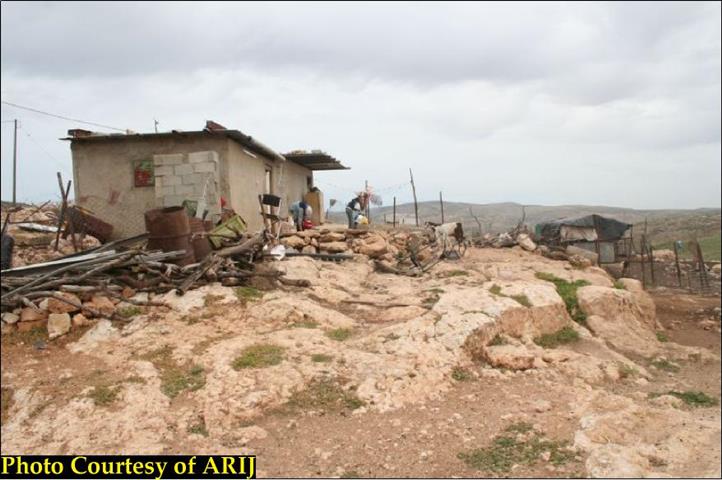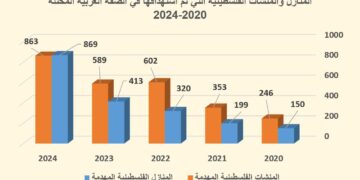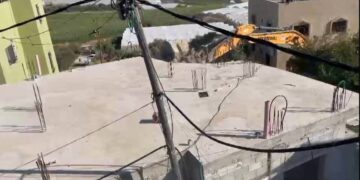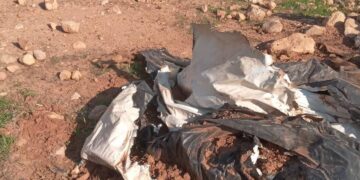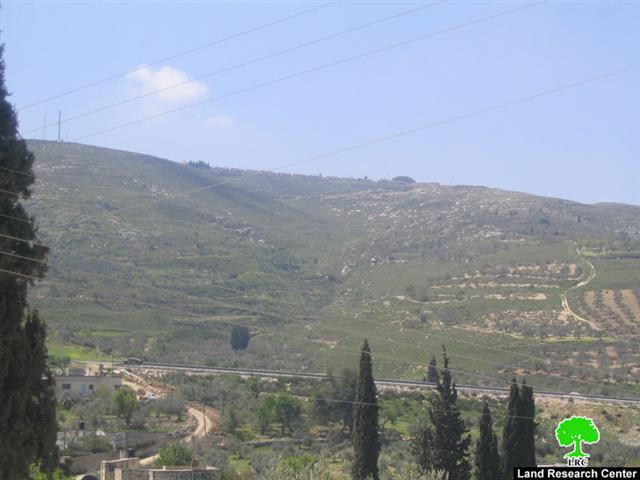On April 21st, 2009, the Israeli Occupation Authorities handed over eight Palestinian families from Lafjam area in ‘Aqraba village southeast of Nablus city military orders notifying them that their houses will be demolished within 48 hours under the pretext of lacking valid building permits. The houses are located in areas classified by the Israelis as ‘closed military areas’ where no Palestinian building and land utilization is allowed. Below are the owners of threatened houses’ in ‘Aqraba Village:
1. Jamil Mohammad Abdullah Bani Jaber.
2. Zeid Mahmud Qasem Bani Jaber.
3. Khalil Rabee’ Bani Jaber.
4. Firas Khalil Rabee’ Bani Jaber.
5. Abdullah Abdel ‘Ghani Bani Jaber
6. Ghallab Ibrahim Muhammad Mayadmah.
7. Mohammad Ibrahim Mohammad Mayadmah.
8. Wasef Ibrahim Mohammad Mayadmah.
Photo 1 & Photo 2: Threatened Palestinian Houses in ‘Aqraba village
In less than 24 hours, the Israeli bulldozers backed by the Israeli Occupation forces staged into the village on the 22ed of April 2009 and demolished five of the threatened houses without giving their owners the chance to salvage their properties. The five demolished houses are owned by:
1. Jamil Mohammad Abdullah Bani Jaber.
2. Zeid Mahmud Qasem Bani Jaber.
3. Khalil Rabee’ Bani Jaber.
4. Firas Khalil Rabee’ Bani Jaber.
5. Abdullah Abdel ‘Ghani Bani Jaber.
The remaining three threatened houses which are owned by Ghallab Ibrahim Muhammad Mayadmah, Mohammad Ibrahim Mohammad Mayadmah and Wasef Ibrahim Mohammad Mayadmah were evacuated and moved to another area in the village to avoid demolition.
Previous Israeli Military Warnings in ‘Aqraba Village
Earlier on November 11th, 2008, the Israeli planning and construction personnel affiliated to the Israeli Civil administration handed over 18 military warnings ordering an immediate halt of construction of a number of Palestinian houses and agricultural structures in Khirbet at Tawil to the east of Aqraba village southeast of Nablus city. The halt-of-construction warnings were issued under the pretext that the targeted structures are located in Area classified as ‘C’ and lack valid building permits from the Israeli Civil Administration. See table 1 for a list of names and a description of the threatened structures:-
|
Table 1: List of owners’ names and description of the threatened structure
|
|
No.
|
Name
|
Description of structure
|
|
1
|
Maher Anas Bani Fadel
|
Barracks
|
|
2
|
Usama Anas Bani Fadel
|
Barracks
|
|
3
|
Sidqi Saleh Bani Fadel
|
A one floor house
|
|
4
|
Mohammed Sidqi Bani Fadel
|
Barracks
|
|
5
|
Akef Wasif Bani Fadel
|
Barracks
|
|
6
|
Attiya Fahmi Bani Fadel
|
A two floor house
|
|
7
|
Mohammed Khader Bani Fadel
|
Barracks
|
|
8
|
Fath Allah Yusif Bani Miniya
|
A two floor house
|
|
9
|
Anwar Sidqi Saleh Bani Fadel
|
Barracks
|
|
10
|
Yusif Naser Allah Bani Fadel
|
Barracks
|
|
11
|
Zahi Hussein Bani Jaber
|
Barracks
|
|
12
|
Samer Hueein Bani Jaber
|
Barracks
|
|
13
|
Radwan Isa Bani Miniya
|
Barracks
|
|
14
|
Samih Ahmad Bani Miniya
|
A one floor house
|
|
15
|
Jamil Ghazi Bani Fadel
|
Barracks
|
|
16
|
—
|
Khirbet at Tawil mosque
|
|
17
|
—
|
Health centre
|
|
18
|
—
|
Electric power station
|
Source: LRC Database 2008
Later on March 7, 2009, the Israeli Occupation Authorities handed over citizens of Khirbet Al Tawil halt of Construction orders against 5 structures (residential structures, agricultural structures, and animal pens) and a Mosque in the hamlet under the pretext of lacking valid building permits. These orders increased the number of threatened houses in At Tawil Hamlet into 24. See Table 2 for a list of the threatened houses
|
Table 2: list of names of the threatened houses
|
|
Name
|
Stop Work Orders
|
Type of Structure
|
Area in m2
|
|
Basem Saleem Bani Jaber
|
143203
|
Agricultural room
|
6
|
|
143201
|
Agricultural brux
|
24
|
|
143204
|
Water cistern
|
Capacity 60 m3
|
|
Mohammad
Adnan Rashayda
|
143205
|
Agricultural room
|
8
|
|
143202
|
Agricultural brux
|
36
|
|
The mosque of Khirbet Al Tawil
|
|
The only mosque in the Khirbet
|
60
|
|
TOTAL
|
134
|
Source: LRC Database 2009
The Israeli Occupation Practices in ‘Aqraba village
Local residents of ‘Aqraba village are suffering from the Israeli colonial practices carried out either at the hands of the Israeli Occupation Army or the Israeli settlers, especially those living in the nearby settlements, Itamar
, which was illegally established on lands of ‘Aqraba in 1984 and houses today a total population of 660 Israeli settlers. Of these harassments, on September 27, 2008, an 18-years old boy called Attiya Bani Minya was killed at the hands of Israeli settlers while he was herding his sheep in Houd Al Fajam area, about 10 kilometers east of ‘Aqraba village. Attiya was found dead in the nearby Valley with more than 20 bullets penetrated his body.
Furthermore, it wasn’t the first time that a herder from ‘Aqraba village was killed at the hands of Israeli settlers; in early 2006, farmer Mohammad Hamdan Bani Jaber was killed in the area of Al ‘Arama located 9 kilometers west of the village of ‘Aqraba and about half a kilometer away from Itamar Settlement. He was herding his sheep when settlers shot him to death. See Map Below:-
‘Aqraba Village: Location and Population
The village of ‘Aqraba is located some 18 kilometers to the southeast of Nablus city; It is bordered by Ad Dawa Village from its northeastern side, the village of Jourish and the settlement of Migdalim from its southern and southwestern sides, The village of Osrin from the west and Tel Al Khashab Hamlet from its southeastern side.
The urban area of the village stands on 1094 dunums of land, about 0.75% of the village’s total land area and is a home to 9537 inhabitants (PCBS 2009), most of who tended to work in Agriculture after loosing their jobs as constructional workers inside Israel following the eruption of the second Intifada in September 2000. Today, the village of ‘Aqraba stands on 146,448 dunums of land.
Land Classification of ‘Aqraba Village Lands:–
In the Oslo II Interim Agreement that was signed in September 1995 between the Palestinians and Israelis, the Palestinian areas in the West Bank were classified into three areas A, B and C which aimed at a phased withdrawal of the Israeli military forces from these areas until the accomplishment of a final status agreement.
Accordingly, the 14794 dunums of ‘Aqraba Village were classified to areas B and C; 14535 Dunums of which were classified as Area B (9.9 % of the total village area) where most of the built up area is concentrated; while the remaining area of the village, a total of 131913 dunums of ‘Aqraba village lands were classified as Area C (90.1 % of the total village area) and contain all the agricultural lands and the open spaces in the village. See Table 3
|
Table 3: Classification of Lands in ‘Aqraba village according to Oslo II Agreement of 1995
|
|
Classification of Area
|
Area in dunums
|
% of the Village’s total area
|
|
Area A
|
0
|
0
|
|
Area B
|
14535
|
9.9
|
|
Area C
|
131913
|
90.1
|
|
Total Area
|
146448
|
100
|
|
ARIJ GIS Database – 2009
|
The Israeli Settlement program in ‘Aqraba Village following the 1967 War
Following Israel’s occupation of the West Bank and the Gaza Strip in 1967, the successive Israeli Governments adopted a policy of land confiscation for the various Israeli purposes which were mostly exemplified in the establishment of Settlements, bypass Roads and military bases. Accordingly, the village of ‘Aqraba witnessed the confiscation of its lands for the establishment of five Israeli settlements which stand on 5939 dunums, 4.1% of the village’s total land area. The settlements are a home to more than 1250 Israeli settlers as illustrated in Table 4 below
|
Table 4: Israeli Settlements in Aqraba Village Boundary
|
|
Israeli Settlement
|
Date of Establishment
|
Population 2007
|
Israeli Built-up Area
|
|
Total Area 2006 in Dunum
|
|
Massu’a
|
1970
|
150
|
46
|
|
Yafit
|
1980
|
119
|
1436
|
|
Peza’el (Fezael)
|
1972
|
242
|
1266
|
|
Tomer
|
1978
|
301
|
1031
|
|
Gilgal
|
1970
|
193
|
930
|
|
Netiv HaGedud
|
1975
|
145
|
458
|
|
Gittit
|
1973
|
237
|
772
|
|
Total Area
|
|
1387
|
5939
|
Source: ARIJ GIS UNIT 2009
House demolition in light of human rights, international covenants and treaties
Adequate housing is one of the basic needs and rights of each person, where ‘the right to adequate housing is the right of every woman, man and child to a place to live in security and dignity.’ In the occupied Palestinian territory, Israel as an occupier should abide by the international human rights treaties to which it is a state party including: The International Covenant on Economic, Social and Cultural Rights (ICESCR) and the International Convention on the Elimination of All Forms of Racial Discrimination,. As an occupier Israel should also abide by the international humanitarian law including: The Hague Regulations and the Forth Geneva Convention. The demolition of houses in ‘Aqraba village would be a stark violation of these rights and covenants. Israel should be held accountable for its acts the Occupied Palestinian Territory; should comply with the international legitimacy, laws treaties and United Nations’ resolutions; and Israel’s long time apathy of the international community’s wills must come to an end.
Following is a synopsis of Articles within these covenants, conventions and laws that address the issue of house demolitions and forced evictions under these articles:
International Covenant on Economic, Social and Cultural Rights
-
Article 11 (1): ‘The States Parties to the present Covenant recognize the right of everyone to an adequate standard of living for himself and his family, including adequate food, clothing and housing, and to the continuous improvement of living conditions’.
International Convention on the Elimination of All Forms of Racial Discrimination (1965)
-
Article 5: ‘States’ Parties undertake to prohibit and eliminate racial discrimination in all of its forms and to guarantee the right of everyone, without distinction as to race, color, or national or ethnic origin, to equality before the law, notably in the enjoyment of the following rights: … (e) in particular … (iii) the right to housing’.
Universal declaration of human rights, Article 17:
1. ‘Everyone has the right to own property alone as well as in association with others.’
2. ‘No one shall be arbitrarily deprived of his property.’
Article 25:
1. ‘Everyone has the right to a standard of living adequate for the health and well-being of himself and of his family, including food, clothing, housing and medical care and necessary social services, and the right to security in the event of unemployment, sickness, disability, widowhood, old age or other lack of livelihood in circumstances beyond his control.’
The Fourth Geneva Convention
-
Article 53: ‘Any destruction by the Occupying Power of real or personal property belonging individually or collectively to private persons, or to the State, or to other public authorities, or to social or cooperative organizations, is prohibited, except where such destruction is rendered absolutely necessary by military operations.’
-
Article 47: ‘Protected persons who are in occupied territory shall not be deprived, in any case or in any manner whatsoever, of the benefits of the present Convention by any change introduced as the result of the occupation of a territory, into the institutions or government of the said territory, nor by any agreement concluded between the authorities of the occupied territory and the Occupying power, nor by any annexation by the latter of the whole or part of the occupied territory.’
-
Article 147: ‘Grave breaches to which the preceding Article relates shall be those involving any of the following acts … extensive destruction and appropriation of property, not justified by military necessity and carried out unlawfully and wantonly.’
Hague Regulations 1907
-
Section II Article 23: ‘it is especially forbidden- to destroy or seize the enemy’s property, unless such destruction or seizure be imperatively demanded by the necessities of war.’
-
Section III Article 46: ‘Family honor and rights, the lives of persons, and private property, as well as religious convictions and practice must be respected. Private property cannot be confiscated.’
Agenda 21 (UNCED, 1992)
Chapter 7.6: ‘Access to safe and healthy shelter is essential to a person’s physical, psychological, social and economic well-being and should be a fundamental part of national and international action. The right to adequate housing as a basic human right is enshrined in the Universal Declaration of Human Rights and the International Covenant on Economic, Social and Cultural Rights. Despite this, it is estimated that at the present time, at least one billion people do not have access to safe and healthy shelter and that if appropriate action is not taken, this number will increase dramatically by the end of the century and beyond.’
‘People should be protected by law against unfair eviction from their homes or land’.
::::::::::_
Itamar settlement was established in the year 1984 on an area of 3097 dunums of lands confiscated from the towns and villages of ‘Awarta, Beit Furik, Al Yanoon and Rujeib in addition to the village of ‘Akraba.
Prepared by


